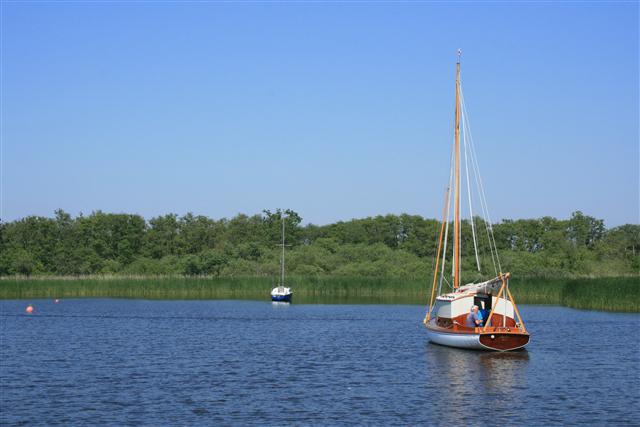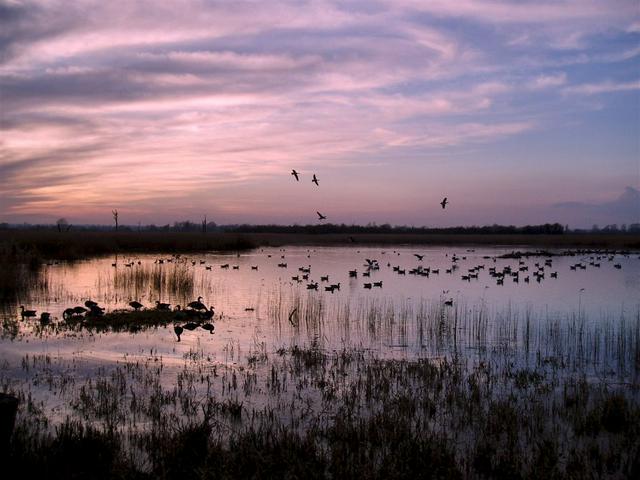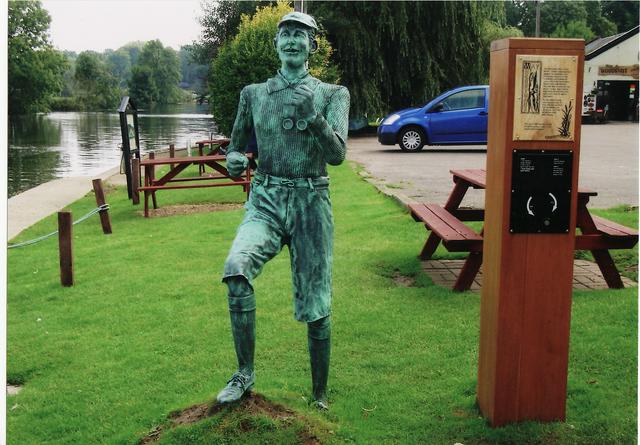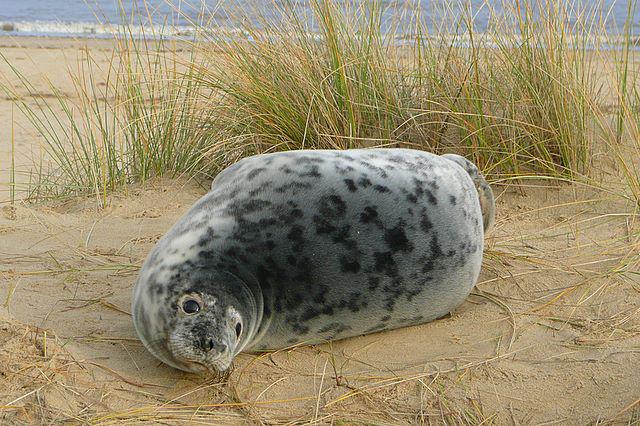
The Norfolk Broads (also commonly referred to as The Broads) is an historic and scenic area in the east of the English county of Norfolk, close to the Suffolk border and also extending into that county. It consists of a network of mostly navigable rivers, lakes and marshes. A large portion of the Broads now falls within the irregular boundaries of the Broads National Park.
For many years the broads were regarded as natural features of the landscape. It was only in the 1960s that Dr Joyce Lambert proved that they were artificial features, the effect of flooding on early peat excavations.
The Romans first exploited the rich peat beds of the area for fuel, and in the Middle Ages the local monasteries began to excavate the peat lands as a business, selling fuel to Norwich and Great Yarmouth. Then the sea levels began to rise, and the pits began to flood. Despite the construction of windpumps and dykes, the flooding continued and resulted in the typical Broads landscape of today, with its reed beds, grazing marshes and wet woodland.
The Broads largely follows the line of the rivers and natural navigations of the area. There are seven navigable rivers, the River Yare and its (direct and indirect) tributaries the Rivers Bure, Thurne, Ant, Waveney, Chet and Wensum.
The broads range in size from small pools to the large expanses of Hickling Broad, Barton Broad and Breydon Water. The broads are unevenly distributed, with far more broads in the northern half of Broadland (the Rivers Bure, Thurne and Ant) than in the central and southern portions (the Rivers Yare, Waveney, Chet and Wensum).
Some of the larger broads form nationally important freshwater marshes.
_-_geograph.org.uk_-_854088-lpHKf.medium.jpg)
The Broads are a very important remnant of the wetlands that once dominated much of the East Anglia. A number of species found here are very scarce in the United Kingdom and even found nowhere else.
The birdlife is especially popular with visitors and specialist broadland species include bittern, which you are more likely to hear than see - they're secretive and well-camouflaged among the reeds, but make a very characteristic 'booming' call which carries quite far and sounds more mechanical than natural. Also look out marsh harrier and bearded tit.
The spectacular yellow and black swallowtail butterfly is found at many locations in the Broads, but nowhere else in the whole of the UK.
The Broads waterways are starting to suffer from increasing threats from invasive species. Of particular concern are 'killer shrimp' (dikerogammarus villosus), mink and signal crayfish as well as a number of invasive plant species: Australian swamp stonecrop, Himalayan balsam, floating pennywort, giant hogweed, Himalayan balsam, Japanese knotweed and parrot's feather. For further information see Broads Authority Invasive Species. The Broads Authority have published a leaflet to improve public awareness and outlining specific steps anglers, boaters, canoeists, kayakers and windsurfers should take to prevent spreading these invaders Broads Authority Advice on preventing spread of invasive species.
Being in East Anglia the Broads enjoy a drier climate than the more western parts of the UK. Winter temperatures range 1-7°C and typically have 10 rain days a month. In summer Jul & Aug range 12-21°C with 9 rain days each month. Winter sunshine hours per month can be as low as 60 hr in Jan but improve to over 200 hr in July. Detailed information can be found on the UK Met Office Norwich Climate page or UK Met Office East of England Climate page.
Although the Broads are a single area under control of a single authority, people often consider the area split into two regions: the Northern Broads and the Southern Broads. The Northern Broads are Rivers Bure, Ant and Thurne and many of the more famous Broads (Wroxham broad, Hickling Broad, Horsey Mere, Salhouse Broad, etc.) whilst the Southern Broads comprise Rivers Wensum, Yare, Chet and Waveney and include Breydon Water and Oulton Broad. Northern Broads can be busier as most tourists seem to focus more on that area.
Slightly separate from the main "Broads" everybody knows are 5 broads on a tributary of the River Bure but with no navigable link to the river nor to the main Broads network. The Trinity Broads comprise 3 larger broads (Rollesby Broad, Ormesby Broad and Filby Broad) and 2 smaller broads (Lily Broad and Ormesby Little Broad). The area has been classified as an area of Special Scientific Interest (SSSI) and recreational access to the area is strictly limited and controlled.
Some broads are not connected to the main river network and thus there is no navigation access. A surpassing number of broads are under private ownership and recreational navigation is barred or restricted. Historically broads were considered part of the King's river and thus free access to all was permitted. However in the 19th century some private landowners used the Inclosures Act to block public access to broads they owned. Prominent local boatbuilder Herbert Woods lead access campaigns and in 1949 held a organised trespass into Hoveton Little Broad (Black Horse Broad), dismantling the barriers blocking Black Horse Dyke access to the broad. The protest resulted in the landowner agreeing to public access through parts of the year (Easter to mid-Sept) but other landowners and closed broads did not allow access. Many will be familiar with the name Herbert Woods from the boat hire company based in Potter Heigham.
Today the Broads Authority are starting to talk to landowners of closed broads with a view to greater public access (focusing on 9 linked but closed broads). Hoveton Great Broad is receiving particular focus as significant public funding is being provided for restoration works.
Predominantly used in the Northeast and East of the UK the term means a wharf of quay. More northern areas tend to use Staith (from the Anglo-Saxon) whilst to the south the term Staithe (with an "e") from the Danish spelling. Across the Broads area the word will be seen all over the place, house names, street names, place names and even some wharfs and quays!
-ZQcFW.medium.jpg) Visitors to the area might notice quite a few "names" incorporating the word "Wherry" e.g. Wherryman's Way footpath, pub names, street names, beers, house names. The word is referring to the Norfolk Wherry, a water craft used for trade and passengers around the broads. Over time the design of the craft varied and to an extent the design and size depended on the waters they were used on but they had a gaff rigged sail with the mast well forward in the hull. Later wherries were around 50 ft long and able to carry 30 tons of cargo. Wherries first came into use in the early 1600s, the last one being built in the early 1900s. There are 8 surviving wherries on the broads, some can be sailing around the broads.
Visitors to the area might notice quite a few "names" incorporating the word "Wherry" e.g. Wherryman's Way footpath, pub names, street names, beers, house names. The word is referring to the Norfolk Wherry, a water craft used for trade and passengers around the broads. Over time the design of the craft varied and to an extent the design and size depended on the waters they were used on but they had a gaff rigged sail with the mast well forward in the hull. Later wherries were around 50 ft long and able to carry 30 tons of cargo. Wherries first came into use in the early 1600s, the last one being built in the early 1900s. There are 8 surviving wherries on the broads, some can be sailing around the broads.
- Norfolk Wherry Trust, Forsythe Wherry Yard, Horsefen Road, Ludham, NR29 5QG.
- Wherry Maud Trust, Forsythe Wherry Yard, Horsefen Rd, Ludham, NR29 5QG. In the era when the broads and associated river network were used to transport goods, (some) wherry operators were not adverse to a bit of smuggling (carrying a couple of barrels of smuggled French brandy would give higher profits than carrying 40 tons of coal). The practice developed where a rapid system of warning signalling evolved using the water pumping windmills. When customs inspections were suspected, a wherry would send a runner to the nearest mill who would then fix their sails in a diagonal orientation (St Andrew's Cross). Neighbouring mills would see this signal and position their sails in the same orientation (the sending mill then resuming normal operations). The signalling system allowed warnings to be sent fast over great distances (it is said to have taken less than 15 min for such a signal to pass from Yarmouth to Horsey). Wherrymen seeing the warning would then sink their illicit cargoes marking the spot with floats made of reeds. The sunken cargos were later picked-up by the mill operators (marshmen) and the profits would be split. The mills were then used to pass an all clear signal by orienting their sails in a horizontal/vertical (St George's Cross) orientation. Despite the warning systems, wherrymen were caught and one is said to have been sentenced to 4 years hard labour and confiscation of his craft (though his friends were quicker than the authorities and sunk the craft in a broad, and when it was raised after the sentence was completed the cargo was still intact).
Norfolk Wherry Trust, Forsythe Wherry Yard, Horsefen Road, Ludham, NR29 5QG.
Wherry Maud Trust, Forsythe Wherry Yard, Horsefen Rd, Ludham, NR29 5QG.
If you are taking your own boat on The Broads (e.g. canoe, kayak, dinghy) even for a day, you will need to pay a toll (buy a licence). How much they cost depends on the type/size of boat and how long you are on The Broads for. See Broads Authority Tolls. Membership of some sporting organisations include a license for your boat on the Broads (e.g. British Canoeing).
There are public and private areas on the broads, and some areas where fishing is not permitted for conservation reasons. You will need an Environment Agency Rod Licence.
Within the confines of the Broads National Park, there are several important conservation areas. Some of the larger specific reserve areas include:

- Bure Marshes NNR.
- Benacre Broad NNR, near Southwold in Suffolk.
-ncCyo.medium.jpg)
- Ant Broads & Marshes NNR. including the major wetland of Barton Broad
- Hickling Broad NNR. A large and important wetland reserve.
- Horsey Mere. Site of Special Scientific Interest (SSSI), owned by National Trust
- Ludham - Potter Heigham NNR. Traditional grazing supporting wide range of wildlife. Keep to public footpaths.
- Redgrave and Lopham Fen NNR.
- Martham Broad NNR.
- Halvergate Marshes.
- Strumpshaw Fen RSPB reserve. In the Yare Valley near Norwich in Norfolk is an important wintering ground for waterfowl and raptors, and a breeding ground for many specialist marshland species.
Bure Marshes NNR.
Benacre Broad NNR, near Southwold in Suffolk.
Ant Broads & Marshes NNR. including the major wetland of Barton Broad
Hickling Broad NNR. A large and important wetland reserve.
Horsey Mere. Site of Special Scientific Interest (SSSI), owned by National Trust
Ludham - Potter Heigham NNR. Traditional grazing supporting wide range of wildlife. Keep to public footpaths.
Redgrave and Lopham Fen NNR.
Martham Broad NNR.
Halvergate Marshes.
Strumpshaw Fen RSPB reserve. In the Yare Valley near [[Norwich]] in [[Norfolk (England)|Norfolk]] is an important wintering ground for waterfowl and raptors, and a breeding ground for many specialist marshland species.
Since the Norfolk Broads is now the UK’s largest nationally protected wetland and an important area for wildlife, there are plenty of outdoor activities to do. You won't find any clubbing spots here but there are many family pub restaurants along the Broads.
One of the main activities is to rent a boat and cruise along the river for a few days, stopping at pubs along the way.
The Broads are ideal for canoeing and kayaking and there are several canoe hire centres around the Broads (full day or part day hire).
- Banks Boat & Canoe Hire, Staithe Cottage, Wayford Bridge, NR12 9LN, +44 1692 582457. 2 person: <3 hr £25, 3-6 hr £40.
- Salhouse Broad Canoe Hire, Lower St, Salhouse NR13 6RX, +44 1603 722775. Canadian canoe (2-3 pers): 1 hr £10, 3 hr £23. Kayak (1 pers): 1 hr £7, 3 hr £15.
- Herbert Woods, The Broads, Bridge Rd, Potter Heigham, NR29 5JF, +44 1692 670711. F Da M Tu 8AM-6PM, W Th 8AM-5PM, Su 9AM-5PM. Full day £36, half day £20.
- Pub & Paddle, The Red Lion Pub on Bishop’s Bridge, Norwich, +44 7886 080875 (mobile). Parking at Red Lion £4 for the day (rate discounted for canoe hire) £20 (4 hr) - £30 (7 hr) per person.
Banks Boat & Canoe Hire, Staithe Cottage, Wayford Bridge, NR12 9LN, +44 1692 582457. 2 person: <3 hr £25, 3-6 hr £40.
Salhouse Broad Canoe Hire, Lower St, Salhouse NR13 6RX, +44 1603 722775. Canadian canoe (2-3 pers): 1 hr £10, 3 hr £23. Kayak (1 pers): 1 hr £7, 3 hr £15.
Herbert Woods, The Broads, Bridge Rd, Potter Heigham, NR29 5JF, +44 1692 670711. F Da M Tu 8AM-6PM, W Th 8AM-5PM, Su 9AM-5PM. Full day £36, half day £20.
Pub & Paddle, The Red Lion Pub on Bishop’s Bridge, Norwich, +44 7886 080875 (mobile). Parking at Red Lion £4 for the day (rate discounted for canoe hire) £20 (4 hr) - £30 (7 hr) per person.
 There are many footpaths and walks around the Broads, both shorter circular routes and longer multi-day walks
There are many footpaths and walks around the Broads, both shorter circular routes and longer multi-day walks
- Wherryman's Way. 35-mile walk following the course of the River Yare between Norwich and Great Yarmouth.
- Angles Way. 93-mile walking trail between Great Yarmouth and Thetford in "Southern Broads". Angles Way by Ramblers Association
Several circular walks described at Discover the Broads .
Wherryman's Way. 35-mile walk following the course of the River Yare between [[Norwich]] and [[Great Yarmouth]].
Angles Way. 93-mile walking trail between [[Great Yarmouth]] and [[Thetford]] in "Southern Broads". Angles Way by Ramblers Association
There are many places where you can hire boats to take out on the Broads, from small day boats through to full family cruisers sleeping aboard for a few weeks, mostly motor boats. A small day boat for a few hours would not normally need booking in advance whilst the holiday sleep aboard cruisers would need advance booking.
- Rowan Craft Ltd, Wherry Dyke, Geldeston, Beccles, NR34 0LY, +44 1508 518208. 8:30AM–1PM, 2–5. Day boat hire 3 hr £50, all day (6 hr) £80. Canoe hire 3 hr £23, all day £35 per canoe; two and three man canoes available.
- Richardson's Boating Holidays, The Staithe, Stalham, NR12 9BX, +44 1692 668981. Provides cruisers from 2 - 12 berth along the Norfolk Broads.
- Wroxham Boat Hire, The Broads Centre, Riverside Road, Wroxham NR12 8UD, +44 1603 783051. 2hrs low season £35, high season £40. Best to book in advance Jul & Aug
- Whispering Reeds Boats Ltd, Staithe Road, Hickling, NR12 0YW, +44 1692 598314. Motor launch, sailing boat, canoe hire.
- Barnes Brinkcraft, Riverside Rd, Wroxham, NR12 8UD (On Hoveton side of River Bure, +44 1603 782625. M-F 8AM-5PM, Sa 9AM-4PM. Day boat £15 per hr, picnic boat £79 per ½ day, canoe £25 per ½ day.
Rowan Craft Ltd, Wherry Dyke, Geldeston, Beccles, NR34 0LY, +44 1508 518208. 8:30AM–1PM, 2–5. Day boat hire 3 hr £50, all day (6 hr) £80. Canoe hire 3 hr £23, all day £35 per canoe; two and three man canoes available.
Richardson's Boating Holidays, The Staithe, Stalham, NR12 9BX, +44 1692 668981. Provides cruisers from 2 - 12 berth along the Norfolk Broads.
Wroxham Boat Hire, The Broads Centre, Riverside Road, Wroxham NR12 8UD, +44 1603 783051. 2hrs low season £35, high season £40. Best to book in advance Jul & Aug
Whispering Reeds Boats Ltd, Staithe Road, Hickling, NR12 0YW, +44 1692 598314. Motor launch, sailing boat, canoe hire.
Barnes Brinkcraft, Riverside Rd, Wroxham, NR12 8UD (On Hoveton side of River Bure, +44 1603 782625. M-F 8AM-5PM, Sa 9AM-4PM. Day boat £15 per hr, picnic boat £79 per ½ day, canoe £25 per ½ day.
 Between late Oct and Feb you can visit the Grey Seals at Horsey Gap (check early and late if seals are present before visiting). A large wild population comes ashore over this time (up on the beach and dunes) to breed and give birth. About half the world population of grey seals live around the UK, and Horsey Gap is one of the larger populations. Some areas have been roped-off for sake of seals; they can be dangerous with the young and males around, but you can watch and see the colony clearly.
Between late Oct and Feb you can visit the Grey Seals at Horsey Gap (check early and late if seals are present before visiting). A large wild population comes ashore over this time (up on the beach and dunes) to breed and give birth. About half the world population of grey seals live around the UK, and Horsey Gap is one of the larger populations. Some areas have been roped-off for sake of seals; they can be dangerous with the young and males around, but you can watch and see the colony clearly.
- Horsey Gap Grey Seal Colony.
Horsey Gap Grey Seal Colony.
- The Broads - A unique National Park. Of all the National Parks, the Broads has a unique combination of land and water space. This Amazon Kindle guide by Clive Tully explores the history of the landscape, its wildlife, recreation opportunities and places to visit.
The Broads - A unique National Park. Of all the National Parks, the Broads has a unique combination of land and water space. This Amazon Kindle guide by Clive Tully explores the history of the landscape, its wildlife, recreation opportunities and places to visit.
- Ken’s Traditional Fish & Chip Restaurant, The Bridge, Norwich Road, Wroxham, NR12 8DA, +44 1603 784445 (Restaurant), +44 1603 783739 (Take away). Summer: daily 11:30AM–8PM; winter: M–Sa 11:30AM–2:30PM & 4:30–7:20PM, Su 11:30AM–6PM. Restaurant, tak-away, tea rooms, coffee shop, vegetarian foods.
- Rushcutters Arms, 46 Yarmouth Road, Thorpe St Andrew, NR7 0HE, +44 1603 435403. Pub: M–Sa 11AM–11PM, Su noon–10:30PM; food: M–Sa 11AM–10PM, Su noon–9:30PM. Pub restaurant.
- The Ship Inn, 8 The Street South, Walsham, NR13 6DQ, +44 1603 270049. Food: M Tu noon–2PM & 6–8PM; W–Sa noon–2PM & 5:30–9PM. Sunday Roast: noon–5:30PM. Pub: M Tu noon–10PM; W Th noon–11PM; F Sa noon– midnight; Su noon–10PM.
- The Swan (Loddon), Church Plain, Loddon, NR14 6LX, +44 1508 528039. M-Sa 11AM-11PM, Su noon-10:30PM.
- Water's Edge, Mill Road, Bramerton, Norfolk NR14 7ED (suitable docking area on the River Yare; can also be accessed from Norwich via the A146, following directions to Kirby Bedon then through Kirby Bedon to Bramerton. Daily noon-3PM (lunch), 6-9PM (dinner). Bar and restaurant. Reservations recommended on weekends. Plenty of outside seating and car parking behind the restaurant.
Ken’s Traditional Fish & Chip Restaurant, The Bridge, Norwich Road, Wroxham, NR12 8DA, +44 1603 784445 (Restaurant), +44 1603 783739 (Take away). Summer: daily 11:30AM–8PM; winter: M–Sa 11:30AM–2:30PM & 4:30–7:20PM, Su 11:30AM–6PM. Restaurant, tak-away, tea rooms, coffee shop, vegetarian foods.
Rushcutters Arms, 46 Yarmouth Road, Thorpe St Andrew, NR7 0HE, +44 1603 435403. Pub: M–Sa 11AM–11PM, Su noon–10:30PM; food: M–Sa 11AM–10PM, Su noon–9:30PM. Pub restaurant.
The Ship Inn, 8 The Street South, Walsham, NR13 6DQ, +44 1603 270049. Food: M Tu noon–2PM & 6–8PM; W–Sa noon–2PM & 5:30–9PM. Sunday Roast: noon–5:30PM. Pub: M Tu noon–10PM; W Th noon–11PM; F Sa noon– midnight; Su noon–10PM.
The Swan (Loddon), Church Plain, Loddon, NR14 6LX, +44 1508 528039. M-Sa 11AM-11PM, Su noon-10:30PM.
Water's Edge, Mill Road, Bramerton, Norfolk NR14 7ED (suitable docking area on the River Yare; can also be accessed from Norwich via the A146, following directions to Kirby Bedon then through Kirby Bedon to Bramerton. Daily noon-3PM (lunch), 6-9PM (dinner). Bar and restaurant. Reservations recommended on weekends. Plenty of outside seating and car parking behind the restaurant.
- The Swan Inn, 10 Lower Street, Horning, NR12 8AA, +44 1692 630316. M–Sa noon–11PM; Su noon–10:30PM. Pub, restaurant.
- The Kings Head, Station Road, Hoveton, NR12 8UR, +44 1603 782429. M–Th 11AM–11PM; F Sa 11AM– midnight; Su noon–11PM. Pub, restaurant, hotel.
- The Boat Shed, Staithway Road, Wroxham, NR12 8TH, +44 1603 783 892. M–F 4–11PM; Sa Su noon–11PM.
- The Ferry House, Ferry Rd, Surlingham, NR14 7AR, +44 1508 538659. Pub: daily 11AM–11PM. Food: daily noon–9PM. Pub, food.
- The Maltsters, The Hill, Ranworth, NR13 6AB, +44 1603 270900. Pub: M–Sa 11AM–10:30PM; Su –9:30PM. Food: daily noon–3PM & 6–9PM. Pub & restaurant. Also camping area £3.95 per person per night.
The Swan Inn, 10 Lower Street, Horning, NR12 8AA, +44 1692 630316. M–Sa noon–11PM; Su noon–10:30PM. Pub, restaurant.
The Kings Head, Station Road, Hoveton, NR12 8UR, +44 1603 782429. M–Th 11AM–11PM; F Sa 11AM– midnight; Su noon–11PM. Pub, restaurant, hotel.
The Boat Shed, Staithway Road, Wroxham, NR12 8TH, +44 1603 783 892. M–F 4–11PM; Sa Su noon–11PM.
The Ferry House, Ferry Rd, Surlingham, NR14 7AR, +44 1508 538659. Pub: daily 11AM–11PM. Food: daily noon–9PM. Pub, food.
The Maltsters, The Hill, Ranworth, NR13 6AB, +44 1603 270900. Pub: M–Sa 11AM–10:30PM; Su –9:30PM. Food: daily noon–3PM & 6–9PM. Pub & restaurant. Also camping area £3.95 per person per night.
Given the wide range of activities in the area, safety considerations depend on what you are doing.
For recommendations for water based activities see Broads Authority Safety Recommendations.
- Norwich
- Wroxham and Hoveton
- Horning
- Potter Heigham
- Great Yarmouth
- Lowestoft
- Cromer
- Beccles and Bungay
